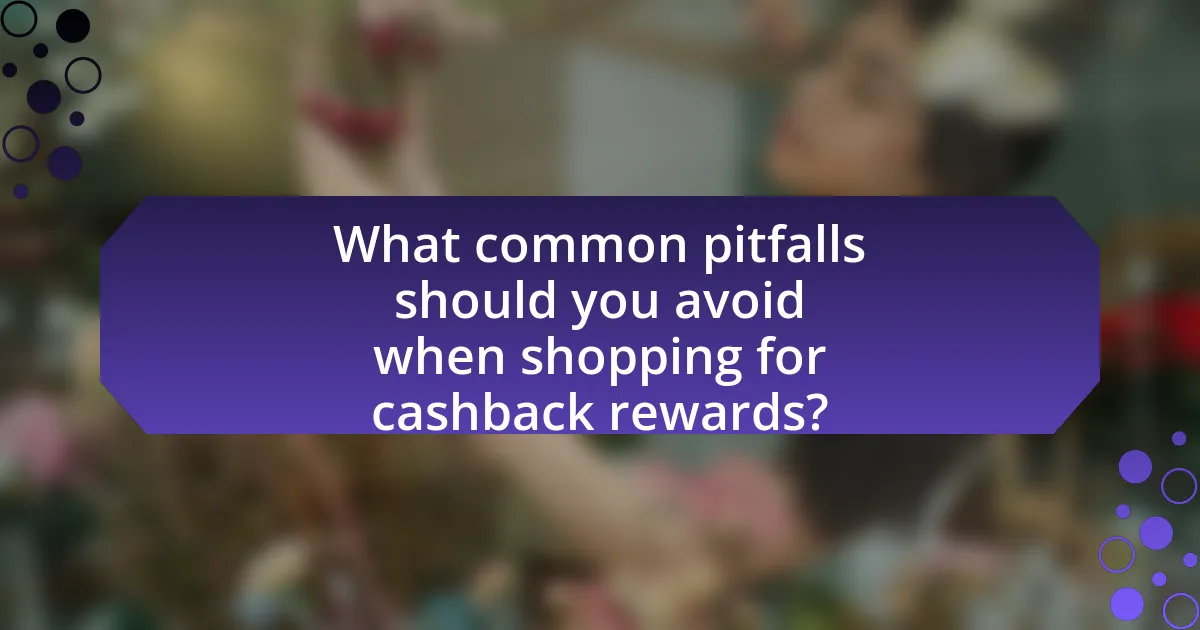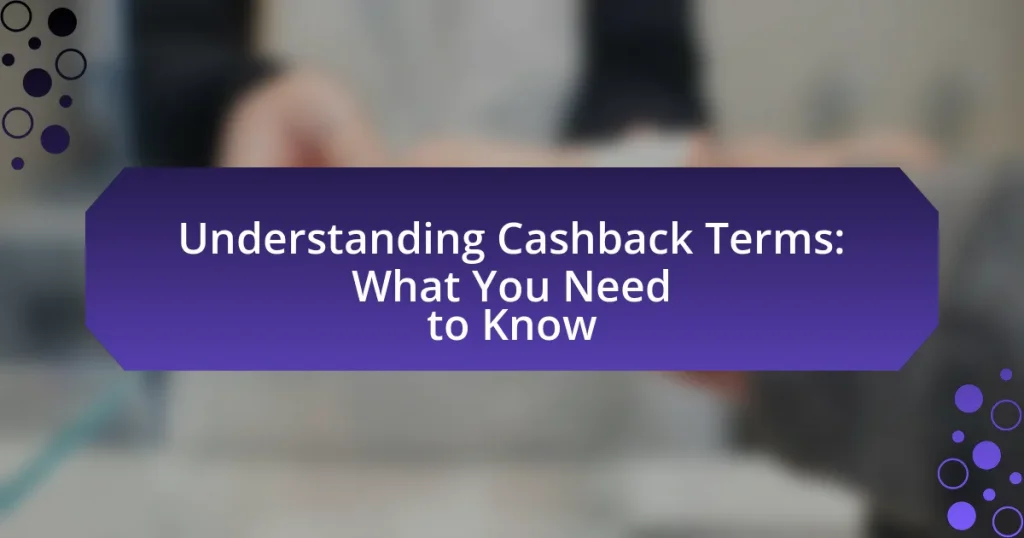The article focuses on optimizing online shopping experiences to maximize cashback rewards. It explains how cashback programs work, detailing various types of rewards such as flat-rate, tiered, and rotating category cashback. The article also outlines strategies for enhancing the shopping experience, including selecting the right cashback programs, tracking earnings, and avoiding common pitfalls. Additionally, it provides tips for combining cashback with other discounts and staying updated on the best offers, ultimately guiding consumers to make informed purchasing decisions that lead to significant savings.

What is the concept of optimizing online shopping for cashback rewards?
The concept of optimizing online shopping for cashback rewards involves strategically selecting retailers and utilizing cashback programs to maximize financial returns on purchases. This optimization can be achieved by comparing cashback rates across various platforms, using browser extensions or apps that track cashback offers, and timing purchases to coincide with promotional events or higher cashback percentages. Research indicates that consumers can earn significant savings; for instance, a study by the National Retail Federation found that shoppers using cashback programs can save an average of 5% to 10% on their total spending.
How does cashback rewards work in online shopping?
Cashback rewards in online shopping work by providing consumers a percentage of their purchase amount back as a rebate. When a shopper makes a purchase through a cashback program, the retailer pays a commission to the cashback provider, which is then shared with the shopper. For example, if a shopper buys a product worth $100 with a 5% cashback offer, they receive $5 back after the transaction is completed. This system incentivizes consumers to shop through specific platforms or retailers that offer cashback deals, enhancing their overall savings while shopping online.
What are the different types of cashback rewards available?
There are several types of cashback rewards available, including flat-rate cashback, tiered cashback, and rotating category cashback. Flat-rate cashback offers a consistent percentage back on all purchases, typically ranging from 1% to 2%. Tiered cashback provides different percentages based on spending thresholds, rewarding higher spending with increased cashback rates. Rotating category cashback features specific categories that change periodically, offering higher cashback rates for purchases made within those categories, often up to 5%. These types of cashback rewards cater to various spending habits and preferences, allowing consumers to maximize their savings based on their shopping behavior.
How do cashback programs calculate rewards?
Cashback programs calculate rewards by applying a percentage of the total purchase amount back to the customer. Typically, this percentage varies based on the retailer, product category, or promotional offers. For instance, a program may offer 1% cashback on general purchases and up to 5% on specific categories like groceries or electronics. This calculation is often automated through the use of tracking technology that monitors purchases made through affiliated retailers. According to a report by the National Retail Federation, cashback incentives can significantly influence consumer spending behavior, encouraging shoppers to choose specific retailers to maximize their rewards.
Why is optimizing your online shopping experience important?
Optimizing your online shopping experience is important because it enhances user satisfaction and increases the likelihood of repeat purchases. A streamlined shopping process reduces cart abandonment rates, which, according to the Baymard Institute, averages around 69.57% across various industries. By improving navigation, load times, and payment options, retailers can significantly boost conversion rates and customer loyalty. Additionally, an optimized experience can lead to higher cashback rewards, as many cashback programs reward users for completing purchases efficiently.
What advantages do cashback rewards provide to consumers?
Cashback rewards provide consumers with direct financial benefits by returning a percentage of their spending as cash. This incentivizes consumers to make purchases, effectively reducing the overall cost of goods and services. According to a 2021 study by the National Retail Federation, 79% of consumers reported that cashback offers influenced their purchasing decisions, highlighting the effectiveness of these rewards in driving consumer behavior. Additionally, cashback rewards can enhance loyalty to specific retailers or credit cards, as consumers are more likely to return to brands that offer them financial incentives.
How can cashback rewards influence purchasing decisions?
Cashback rewards significantly influence purchasing decisions by providing financial incentives that encourage consumers to choose specific products or retailers. Research indicates that 79% of consumers are more likely to shop at retailers that offer cashback rewards, as these incentives create a perception of added value and savings. This financial benefit can lead to increased spending, as consumers may feel justified in purchasing higher-priced items when they know they will receive a percentage back. Additionally, cashback programs can foster brand loyalty, as customers are more inclined to return to retailers that reward them for their purchases, further solidifying their purchasing habits.

What strategies can enhance your online shopping experience for cashback rewards?
To enhance your online shopping experience for cashback rewards, utilize cashback websites and apps that aggregate offers from various retailers. These platforms, such as Rakuten and TopCashback, provide users with a percentage of their purchase back when shopping through their links. Research indicates that consumers can earn an average of 1% to 10% cashback on purchases, depending on the retailer and the specific promotion. Additionally, signing up for credit cards that offer cashback on purchases can further increase rewards, as many cards provide 1% to 5% cashback on different categories. Combining these strategies maximizes potential earnings while shopping online.
How can you choose the right cashback program?
To choose the right cashback program, evaluate the percentage of cashback offered on purchases, the categories eligible for cashback, and any associated fees. Programs that provide higher cashback rates on categories where you spend the most, such as groceries or gas, are typically more beneficial. For instance, some programs offer up to 5% cashback on specific categories, while others may have a flat rate of 1-2%. Additionally, consider the ease of redeeming cashback and whether the program has any restrictions or expiration dates on rewards. Programs with straightforward redemption processes and no hidden fees tend to provide a better overall experience.
What factors should you consider when selecting a cashback program?
When selecting a cashback program, consider the cashback rate, redemption options, fees, and participating retailers. The cashback rate determines how much you earn on purchases; higher rates yield more savings. Redemption options, such as direct deposits or gift cards, affect how easily you can access your rewards. Fees, including annual fees or transaction fees, can reduce overall benefits, so it’s essential to evaluate them. Lastly, the range of participating retailers influences your ability to earn cashback on everyday purchases, making it crucial to choose a program that aligns with your shopping habits.
How do different cashback programs compare in terms of benefits?
Different cashback programs vary significantly in terms of benefits, primarily based on their reward rates, redemption options, and associated fees. For instance, some programs offer higher cashback percentages on specific categories like groceries or travel, while others provide a flat rate across all purchases. Programs such as Rakuten offer up to 40% cashback from select retailers, whereas credit card cashback programs typically range from 1% to 5% depending on the spending category. Additionally, some cashback programs allow for immediate redemption, while others may require a minimum threshold before cashing out, impacting the overall user experience. The effectiveness of a cashback program can also be influenced by membership fees; for example, premium programs may charge an annual fee but offer enhanced rewards. Thus, consumers should evaluate these factors to determine which cashback program aligns best with their shopping habits and financial goals.
What are the best practices for maximizing cashback rewards?
To maximize cashback rewards, consumers should strategically choose credit cards that offer high cashback rates on their most frequent spending categories. For instance, many credit cards provide elevated cashback percentages for groceries, gas, or dining, which can significantly increase overall rewards. Additionally, utilizing cashback websites or apps when making online purchases can further enhance earnings, as these platforms often provide extra cashback incentives for shopping through their links.
Furthermore, consumers should regularly review and adjust their spending habits to align with promotional offers from their credit card providers, as many cards feature rotating categories that can yield higher rewards during specific periods. According to a study by the Consumer Financial Protection Bureau, consumers who actively engage with their credit card rewards programs can earn up to 5% more in cashback compared to those who do not. By combining these strategies, individuals can effectively maximize their cashback rewards.
How can you effectively track your cashback earnings?
To effectively track your cashback earnings, utilize cashback tracking apps or websites that consolidate your purchases and earnings in one place. These tools often link directly to your bank accounts or credit cards, automatically updating your cashback status after each transaction. For instance, platforms like Rakuten and Ibotta provide real-time tracking and notifications about your cashback balance, ensuring you stay informed about your earnings. Additionally, maintaining a spreadsheet to manually log purchases and cashback amounts can serve as a backup method, allowing for easy monitoring and verification of your earnings over time.
What tools or apps can assist in optimizing cashback rewards?
Cashback optimization tools and apps include Rakuten, Honey, and Ibotta. Rakuten offers cashback on purchases from various retailers, providing users with a percentage back on their spending. Honey automatically applies coupon codes at checkout and tracks price drops, maximizing savings. Ibotta allows users to earn cashback on grocery purchases by submitting receipts and offers various bonuses. These tools enhance the cashback experience by ensuring users receive the best possible rewards on their purchases.

What common pitfalls should you avoid when shopping for cashback rewards?
When shopping for cashback rewards, you should avoid common pitfalls such as overlooking the terms and conditions of cashback offers. Many consumers fail to read the fine print, which can lead to missed opportunities or disqualified purchases. For instance, certain cashback programs may exclude specific categories or require a minimum spend, which can affect the total cashback earned. Additionally, not tracking expiration dates for cashback offers can result in lost rewards, as many programs have time-sensitive promotions. Lastly, relying solely on cashback without considering the overall price can lead to overspending; it is essential to evaluate whether the purchase is genuinely beneficial beyond the cashback incentive.
How can you prevent missing out on cashback opportunities?
To prevent missing out on cashback opportunities, consistently use cashback websites or apps before making purchases. These platforms aggregate offers from various retailers, ensuring you access the best available cashback rates. Research indicates that users who regularly check cashback sites can earn up to 10% more on their purchases compared to those who do not. Additionally, subscribing to retailer newsletters and following them on social media can provide exclusive cashback promotions, further enhancing your savings potential.
What mistakes do shoppers often make with cashback programs?
Shoppers often make the mistake of not reading the terms and conditions of cashback programs, which can lead to missed opportunities for earning rewards. Many cashback programs have specific requirements, such as minimum purchase amounts or exclusions on certain products, that shoppers overlook. For instance, a study by the National Retail Federation found that 40% of consumers do not fully understand the terms of the cashback offers they use, resulting in unclaimed rewards. Additionally, shoppers frequently fail to track their cashback earnings, leading to confusion about available rewards and expiration dates. This lack of awareness can cause them to lose out on potential savings.
How can you ensure you meet the requirements for cashback rewards?
To ensure you meet the requirements for cashback rewards, consistently review the terms and conditions of the cashback program you are participating in. Cashback programs often have specific criteria such as minimum purchase amounts, eligible product categories, and time frames for purchases to qualify for rewards. For example, a program may require that you spend at least $25 on specific items to earn 5% cashback. By understanding these requirements and adhering to them, you can maximize your cashback earnings effectively.
What tips can help you successfully optimize your online shopping for cashback rewards?
To successfully optimize your online shopping for cashback rewards, utilize cashback websites and apps that aggregate offers from various retailers. These platforms often provide higher cashback percentages than shopping directly through retailer websites. For instance, Rakuten and TopCashback frequently offer cashback rates ranging from 1% to 15% or more, depending on the retailer and promotional periods. Additionally, always check for coupon codes before completing a purchase, as combining these with cashback offers can maximize savings. Research indicates that consumers who actively seek out and apply coupon codes can save an average of 20% on their purchases. Lastly, consider signing up for loyalty programs of your frequently visited retailers, as they often provide exclusive cashback offers and bonuses for members.
How can you stay updated on the best cashback offers?
To stay updated on the best cashback offers, regularly check cashback websites and apps that aggregate deals, such as Rakuten, Honey, or Ibotta. These platforms provide real-time updates on cashback opportunities from various retailers, ensuring you have access to the latest offers. Additionally, subscribing to newsletters from these cashback services can deliver curated deals directly to your inbox, enhancing your ability to find the best offers. Research indicates that users who actively engage with these platforms can maximize their savings, as cashback rates can fluctuate frequently based on promotions and retailer partnerships.
What are some effective strategies for combining cashback with other discounts?
Effective strategies for combining cashback with other discounts include using cashback credit cards alongside promotional sales and stacking coupons with cashback offers. Cashback credit cards typically provide a percentage back on purchases, which can be maximized during sales events where additional discounts are applied. For instance, if a retailer offers a 20% off sale and a cashback card provides 5% back, the total savings can be substantial. Additionally, many retailers allow the use of coupons on top of cashback offers, enabling shoppers to apply a discount code at checkout while still earning cashback. This approach not only enhances savings but also leverages multiple incentives to optimize the overall shopping experience.



